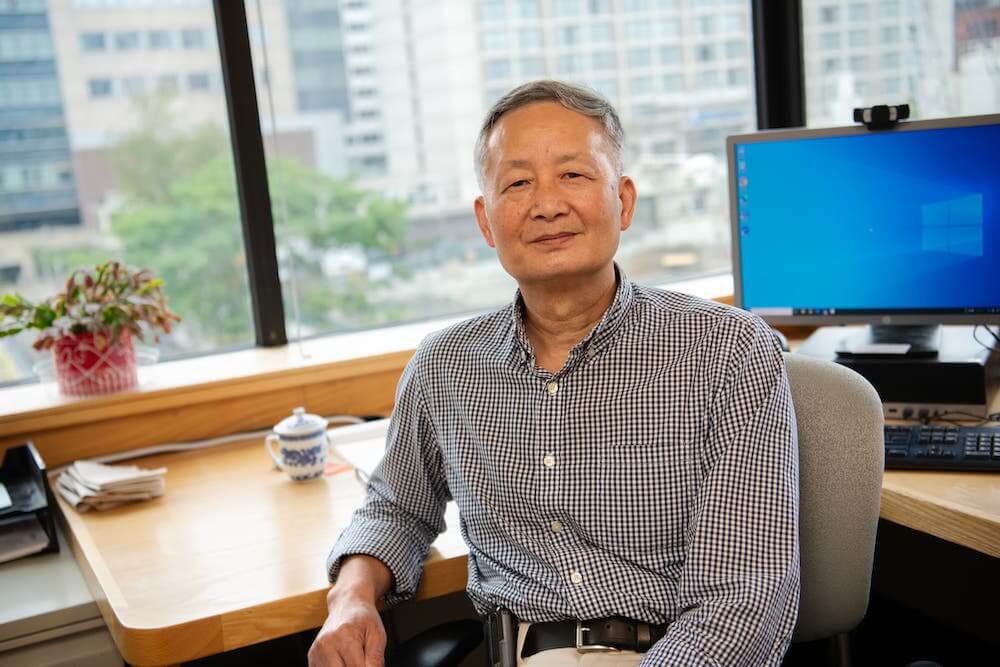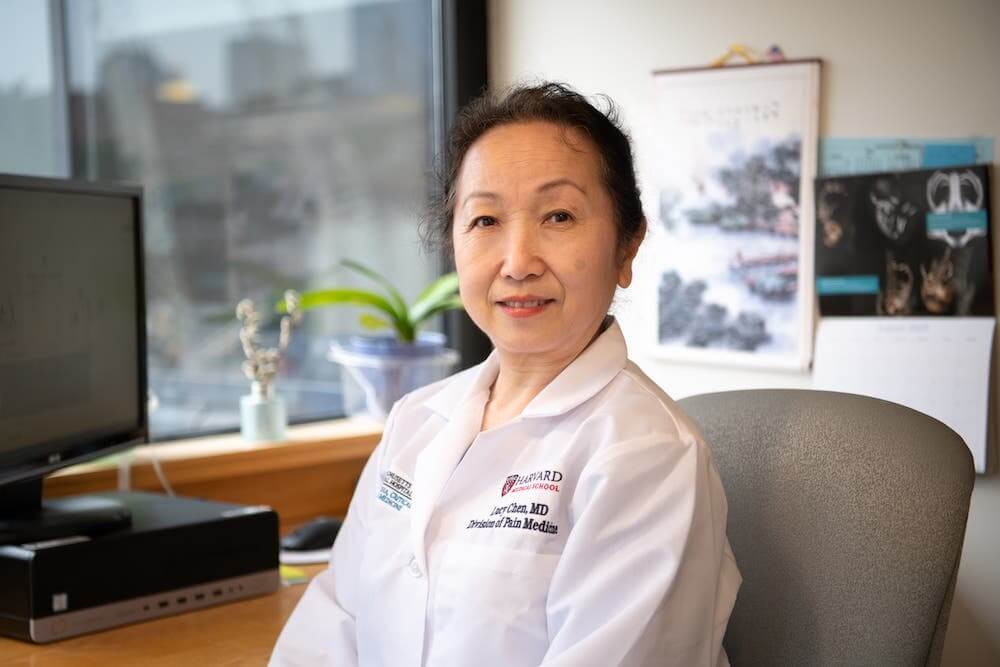Staff Story5 Minute ReadAug | 15 | 2023
Spotlight: Dr. Lucy Chen and Dr. Jianren Mao


Lucy Chen, MD, and Jianren Mao, MD, PhD, clinician-researchers at Massachusetts General Hospital who have collaborated in research over many years, are known by their peers for the extraordinary impact they have made in pain management and patient care.
One of the first female pioneers in the male-dominated field of pain medicine, Dr. Chen’s research has focused on chronic pain, opioid therapy, and alternative medicine such as acupuncture. She has served in many roles at MGH, including as the director of the department’s Acupuncture Clinic, resident education program, Pain Quality Assurance Committee, and Pain Fellowship Clinical Competence Committee.
Throughout his 40-year career in pain research and nearly 25 years of pain practice at MGH, Dr. Mao has led basic science, clinical, and translational research to enhance our understanding of the mechanisms of pain and the effects of opioid therapy. In 2005, he established the MGH Center for Translational Pain Research, the department’s first neuroscience and pain research facility for basic science and clinical research projects. In 2010 and 2015, he took on the roles of departmental vice chair for research and innovation and chief of the Division of Pain Medicine, respectively.
In celebration of their next adventure together—retirement from clinical practice—Dr. Chen and Dr. Mao share more about their specific areas of clinical and research expertise, their experiences throughout their careers, and their visions for the future of pain management.
How has your research impacted patient care?
Dr. Chen: To reduce the pain that our patients experience, we need to know the etiology, mechanism, and treatment options for different chronic pain conditions. My research in acupuncture, opioid therapy, and other clinical conditions is centered on these goals, specifically by focusing on finding novel pain treatments. For example, acupuncture is effective in reducing pain for patients with various conditions with minimal side effects compared to drug therapy and interventional procedures.
Dr. Mao: There are many ways that basic, clinical, and translational research impacts patient care. The Center for Translational Pain Research has served as (1) an NIH-sponsored clinical research site in a number of clinical studies, (2) a part of the NIH HEAL initiative to improve chronic pain management and mitigate the impact of opioid crisis through developing new pain therapeutics, and (3) a leader in studies of opioid-induced hyperalgesia to provide the field with new guidance for managing chronic pain patients with opioid therapy.
Dr. Mao, what was the impetus for the launch of the MGH Center for Translational Pain Research?

Dr. Mao: A major challenge in pain research is to translate research outcomes from preclinical studies to clinical care for patients. The Center’s goal is to bridge that gap as much as possible through establishing a research facility that fosters collaboration between basic science researchers and clinicians.
There is a great need to continue this research to establish innovative pain therapeutics without addiction liability, new interventional pain procedures, and intra- and inter-disciplinary collaboration among various specialties involved in chronic pain management.
What were your focuses during your time as the division chief of pain medicine?
Dr. Mao: I was committed to providing our patients with the best possible and most up-to-date pain management options available. As an academic clinical division, we maintained the unwavering support for scholarly activity in both education and research. As part of a prestigious hospital, we aimed to integrate the history of this leading hospital into the frontiers of modern medical research to make our division one of the best in the field.
How have you seen the approach to pain management evolve during your time as chief?
Dr. Mao: There is an improved awareness around several issues—that pain management is a multidisciplinary effort, that pain medications alone as a mainstay of care (particularly opioid therapy) have significant limitations, and that some chronic pain conditions, such as pain due to degenerative spine disease and joint disease, are considered as a “disease entity” similar to other chronic illnesses, meaning that they are unlikely to be resolved with an acute course of medical or interventional management.
I also believe that today, there is better utilization of innovative interventional procedures as well as the increasing use of alternative treatment options, such as acupuncture—particularly as most insurance plans now provide coverage for them.
Dr. Chen, how did you become interested in the use of acupuncture in pain management?
 Dr. Chen: I learned about acupuncture early in my career and quickly became passionate about integrating it, like many other therapies, into pain medicine. Our studies indicate that acupuncture is a rather promising treatment in chronic pain management, particularly for patients who do not respond well to medications and interventional procedures. Acupuncture can be used independently or as a complementary therapy in integrative pain medicine.
Dr. Chen: I learned about acupuncture early in my career and quickly became passionate about integrating it, like many other therapies, into pain medicine. Our studies indicate that acupuncture is a rather promising treatment in chronic pain management, particularly for patients who do not respond well to medications and interventional procedures. Acupuncture can be used independently or as a complementary therapy in integrative pain medicine.
Since then, I have led the Acupuncture Clinic, credentialed acupuncturists at MGH, and led a research project to study an innovative, objective acupuncture assessment tool by integrating quantitative sensory testing and biomarker assays with conventional pain assessment scales.
How common is it to use alternative medicine in pain management?
Dr. Chen: Approximately 38% of adults and 12% of children in the U.S. use complementary alternative medicine as part of their health maintenance and/or treatment. At Mass General, we have offered acupuncture treatment for more than 20 years. When used appropriately, it has a lower incidence of adverse effects than that of many drugs and commonly accepted medical procedures.
How can more women pain practitioners uniquely impact the field?
Dr. Chen: Based on 2019 data, women pain physicians are still underrepresented, accounting for only 18% of all U.S. practicing pain physicians. Promoting women pain physicians is vital to the growth and success of our profession. Some female patients may find it easier to communicate with female physicians, particularly with certain pain complaints. Others may have personal or cultural reasons to prefer female physicians. Since the physician-patient relationship in pain medicine is important, patients should be able to receive care from a diverse pool of highly qualified professionals.
What are you most looking forward to in retirement from clinical practice?
Dr. Chen: I will be doing more clinical or translational research work after I retire from clinical patient care. I also look forward to spending more time exploring many other interests in life.
Dr. Mao: While I will no longer be involved in clinical practice by the end of 2023 fiscal year, I will continue with my research career at MGH. Without daily involvement in clinical issues, I hope to travel more.
Contributors
-
![]()
- Department of Anesthesia, Critical Care and Pain Medicine
-
![]()
- Chief, Division of Pain Medicine
- Vice Chair for Research
- Director, MGH Center for Translational Pain Research
Type
Centers and Departments
News and Events
Learn about the latest news and events from the Department of Anesthesia, Critical Care and Pain Medicine at Massachusetts General Hospital.
About the Pain Management Center
The Pain Management Center at Massachusetts General Hospital is committed to improving the quality of life for individuals who suffer from chronic pain. We work in partnership with referring physicians to provide care for patients with chronic or acute pain.


